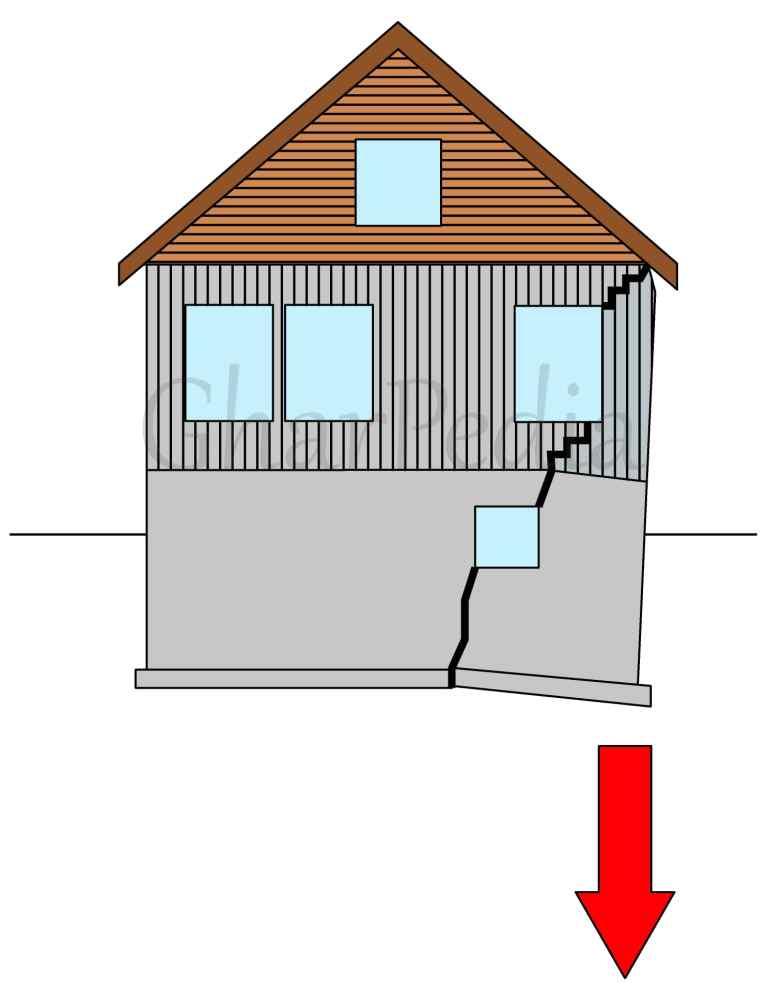
When the soils beneath the structure show a reduction in strength to bear the load above it, the structure will start to sink. This sinking is called as settlement of the structure. This settlement can occur during the construction of the structure or during the service period.

Differential Settlement of the Building
When the settlement of the entire structure is not even i.e. not same for all footing and for all wall, it is known as differential settlement. Differential settlement is an undesirable factor for civil structures. More is the unevenness in settlement, greater will be the problem for the structures.
Definition of Differential Settlement:
The differential settlement can be taken as the difference of settlement between the adjacent columns of the building. This can also be defined as the difference in the elevation across the boundary of the building.
If we need to determine the differential settlement after addition of a structure to an old one, the difference in the elevation of the new addition and the existing building structure will give the differential settlement if any. Always the differential settlement is mentioned by stating the conditions taken into consideration.
The Table-1 below shows the accepted levels of settlement for different types of structure.
Allowable Settlement Values | |
Type of Structure | Allowable Settlement in inches |
| Institutional /Commercial Building | 1 in / 25.4 mm |
| Industrial Buildings | 1.5 in / 38.1 mm |
| Ware Houses | 2 in / 50.8 mm |
| Machine Foundations | < .002in / 0.051 mm |
Causes of Differential Settlement:
Unequal settlement of the structure (pier foundation or footing) due to lose of strength of soil will result in differential settlement. During this differential settlement process, the soil underneath the structure will experience expansion and/or contraction. Due to expansion and/or contraction structure may shifts away. The main reasons for the shifting are:
- Highly Expansive Soil
- Frost action in soils
- Drought conditions of the site
- Flooding problems
- Poor drainage
- Poorly compacted soil system
- Vibration from the nearby construction site
- Foundation over poor soil
- Alternating wetting and drying of soil at foundation level
After Effects of Differential Settlement:
Differential settlement of a structure will directly result in the cracks. These cracks caused due to settlement will be at 45 degrees in angle. These types of cracks are mainly observed over or below the doors or the window openings. The crack visible at the top is usually wider compared with the one seen at the bottom.
Note: The cracks that are observed in the buildings due to temperature variation must not be misunderstood as settlement cracks.
Other Problems from the Differential Settlement are:
- Tilting of the chimney
- Walls bulging
- Sunken Slabs
- Leaks through the openings
- Sinking of exterior stairs
- Resistance of Differential Settlement
Differential settlement in structures can be tolerated by the structure by several means. This tolerating capacity will depend on the following factors:
- The type of the structure
- The spacing of the columns and overall structural framing plan
- Structure is tied in all dimensions or separated to the buildings
- Presence of fixed arch if any will result in abutment settlement
- Greater distortion can be tolerated by simple span frames
- Pile settlement or pier construction is critical
- Truss arrangement in structure is critical
For Avoiding Differential Settlement:
- Proper geotechnical investigation of the soil
- Study the surrounding environment
- The soil over which the building is constructed must not be expansive in nature
- Proper tie beam system
- Proper soil treatment i.e. strengthening of the soil
- If possible lay all the foundations at the same level
- Avoid foundation at a layer which is in alternatively drying and wetting
- Proper tie beam system
- Proper soil treatment before laying foundation
If it becomes necessary to build over weak soil, pile foundations have to be extended till a hard stratum is reached.
If needed seek help from the engineer to assess the results of soil investigations for the settlement value prior to the construction process. For this value, special treatments have to be performed on the soil before the construction of the structure. This will help in reducing the differential settlement.
Deal with Differential Settlement?
Immediately as you observe differential settlement, it is recommended to consult a structural engineer. The engineer will help in assessing whether the damage is to be addressed or not. If the damage is severe, the cause of settlement has to be studied by the engineer and the solution to be explained to fix the issue.
Early addressing of the issues is always good for the building. Treatment during minimal issues will help in increasing the service life of the building. This will stop the propagation of these small damages.
Also Read:
8 Basic Causes of Cracks in House
Building Failures due to Early Ageing
Author Bio
Neenu S. K.
































